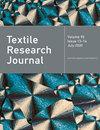通过将有监督的机器学习与刺绣织物电容传感器相结合来检测人体运动
IF 1.9
4区 工程技术
Q2 MATERIALS SCIENCE, TEXTILES
引用次数: 0
摘要
本研究通过引入一种利用电容测量和半监督机器学习算法(即基于人工智能的自动编码器)的织物传感器,为呼吸模式检测做出了贡献。该传感器由两个由镀银导电尼龙丝组成的绣花电极组成,利用人体作为介电材料。在研究中,采用了服装型呼吸传感器来连续监测静态(站立)和动态(步行、快走、跑步)动作时的呼吸数据。稀疏自动编码器算法尤其适用于单个静态和动态动作,可有效区分各种动作对应的呼吸模式。此外,稀疏自动编码器有助于防止过度拟合,从根本上减少信号压缩和重建之间的误差。最大历元数设定为 2000,目标误差设定为 0.005。所有数据都与作为训练基线的静态行走进行了比较。最终,静态姿势之间的均方根误差(RMSE)平均为 0.1,而步行、快走和跑步等动态动作之间的均方根误差分别为 0.61、0.91 和 2.78。这些结果表明,通过误差检测进行运动检测是切实可行的,并且具有明显的功能。本文章由计算机程序翻译,如有差异,请以英文原文为准。
Detection of human movement by combining supervised machine learning and an embroidered textile capacitance sensor
This study contributes to respiratory pattern detection by introducing a fabric sensor utilizing capacitance measurement and a semi-supervised machine learning algorithm known as an AI-based autoencoder. The sensor, consisting of two embroidered electrodes composed of silver-coated conductive nylon filaments, leverages the body as a dielectric material. In the research, a garment-type respiratory sensor was employed to continuously monitor respiratory data during both static (standing) and dynamic (walking, brisk walking, running) actions. The sparse autoencoder algorithm was particularly employed for individual static and dynamic actions, effectively distinguishing respiratory patterns corresponding to various movements. In addition, the sparse autoencoder helps prevent overfitting, fundamentally minimizing errors between the compression and reconstruction of signals. The maximum number of epochs was set to 2000, and the target error was set at 0.005. All data were compared against the static walking as the training baseline. Ultimately, the root mean squared error (RMSE) between static postures averaged 0.1, while the RMSEs between dynamic actions of walking, brisk walking, and running were 0.61, 0.91, and 2.78, respectively. These results suggest that movement detection through error detection is practically feasible and possesses discernible capabilities.
求助全文
通过发布文献求助,成功后即可免费获取论文全文。
去求助
来源期刊

Textile Research Journal
工程技术-材料科学:纺织
CiteScore
4.00
自引率
21.70%
发文量
309
审稿时长
1.5 months
期刊介绍:
The Textile Research Journal is the leading peer reviewed Journal for textile research. It is devoted to the dissemination of fundamental, theoretical and applied scientific knowledge in materials, chemistry, manufacture and system sciences related to fibers, fibrous assemblies and textiles. The Journal serves authors and subscribers worldwide, and it is selective in accepting contributions on the basis of merit, novelty and originality.
 求助内容:
求助内容: 应助结果提醒方式:
应助结果提醒方式:


